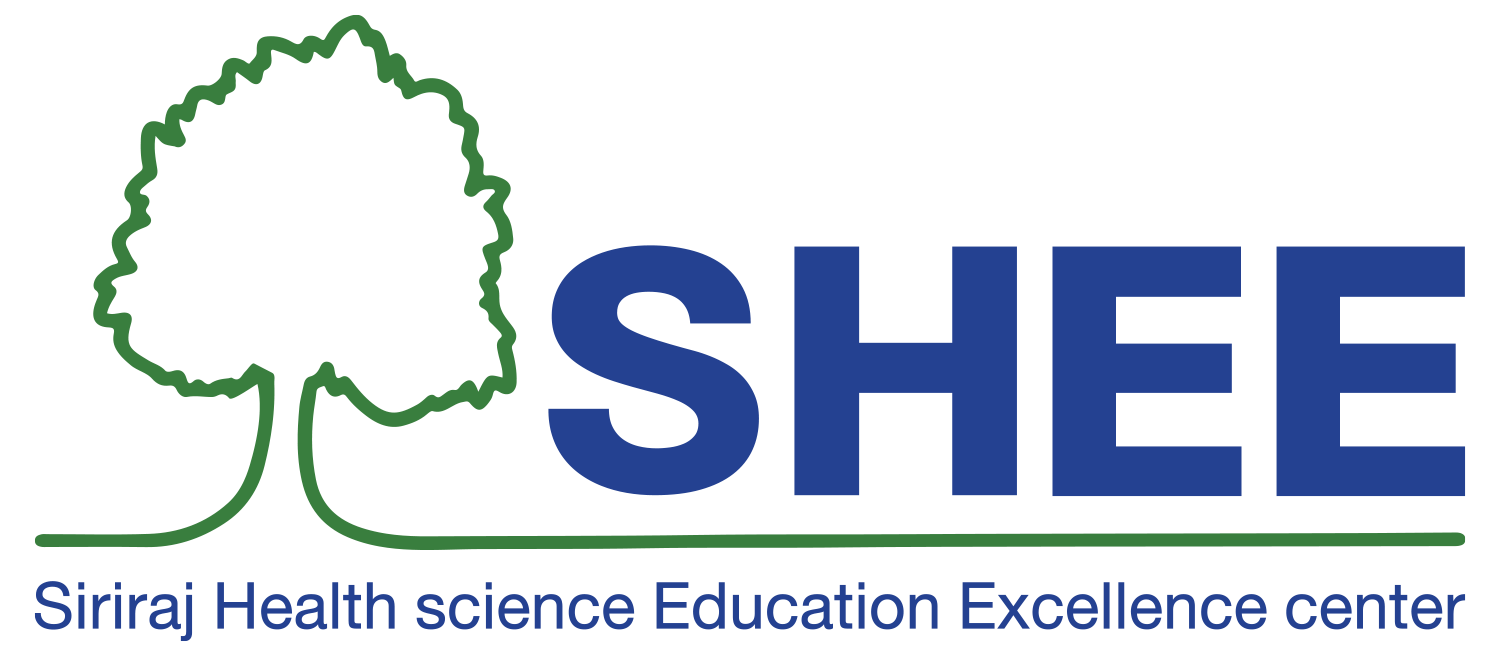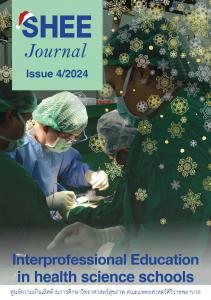SHEE Journal No. 4 2024 (Full Version)
This issue of the SHEE Journal introduces the foundational concepts of Interprofessional Education (IPE), building upon the core competencies that serve as critical objectives in IPE instruction. The authors present concrete approaches to implementing IPE, including teaching in the context of community-based medicine and simulation-based IPE. Another key aspect covered in this issue is evaluation, with an article outlining methods for assessing interprofessional competencies.
Additionally, the editorial team conducted interviews with medical students to gather their experiences and perspectives on interprofessional learning. These insights are expected to enhance readers' understanding of students' viewpoints.
In the Education Movement column, I have proposed strategies to promote and support IPE teaching within the context of Thai health sciences schools. Meanwhile, the SHEE Sharing section features an article on developing interprofessional competencies through work-based learning in a pediatric ward. This example may serve as a practical teaching model for medical educators interested in incorporating similar methods into their instruction.
Issue4/2024-01 Executive talk
Providing effective patient care today requires collaboration among professionals from various disciplines. It can be said that there is virtually no context in which a physician can deliver efficient care without assistance or support from other healthcare personnel. Therefore, the design of educational systems should enable effective interprofessional collaboration.
Traditional teaching methods often involve uniprofessional education, where each profession learns exclusively within its own domain. This approach has proven problematic, as many medical and health sciences graduates lack understanding of how other professionals work and how to collaborate effectively. This misunderstanding can lead to inefficiencies and, ultimately, impact patient safety.
To address these issues, early developments in education introduced multiprofessional education, which allows learners to spend time listening to and understanding the perspectives, thought processes, and work methods of other professions. This approach has helped medical graduates recognize the importance of cooperation and mutual support among professionals from different fields. However, such curricula fall short in developing the actual skills needed for interprofessional collaboration.
The educational approach that truly addresses the needs of interprofessional teamwork is Interprofessional Education (IPE), where learners gain knowledge and skills by working collaboratively with peers from other disciplines. This method fosters the competencies necessary for effective teamwork in real-world healthcare settings.
Author: Assoc. Prof. Dr.Cherdsak Iramaneerat
Downloads: 33
Issue4/2024-02 Core Competencies for Interprofessional Collaborative Practice
Health professional education must encompass not only basic science and clinical science but also place significant emphasis on health systems science. This domain includes critical topics such as patient safety, rational drug use, quality improvement, interprofessional teamwork, and leadership.
Given the increasing complexity of modern healthcare systems, many of which remain fragmented and lack seamless integration, the likelihood of medical errors rises. These errors are frequently reported in the news, with miscommunication being a major contributing factor.
One effective measure to prevent or reduce medical errors and improve patient health outcomes is delivering comprehensive, holistic care through interprofessional collaboration. This approach ensures that healthcare services are coordinated, efficient, and patient-centered.
Author: Assist. Prof. Dr. Natthasiri Thanawut, Ph.D.
Downloads: 34
Issue4/2024- 03 Teaching IPE Through Community-based Medicine
Learning that occurs when individuals from two or more professional disciplines engage in exchanging experiences, interacting with one another, making joint decisions based on shared information, opinions, and feedback, and collectively taking responsibility for the outcomes of those decisions is characteristic of Interprofessional Education (IPE).
If any component is missing—for example, if there is an exchange of experiences but no joint decision-making, and the decision-making authority remains centralized with one individual—this constitutes multiprofessional learning or practice rather than true IPE. Such an approach falls short of achieving IPE’s objective: to build competencies for effective teamwork that respects the roles and responsibilities of all participants, with a patient-centered focus.
Author: Assist. Prof. Dr. Mayuree Homsanit, M.D.
Downloads: 31
Issue4/2024- 04 Simulation-based learning for effective interprofessional education
Interprofessional Education (IPE) plays a crucial role in preparing learners in the medical sciences to work collaboratively across various professional disciplines in team-based environments. When integrated into lessons through Simulation-Based Learning, a teaching approach that fosters learning by creating realistic clinical scenarios in a controlled environment, it enhances the educational experience. This method aligns with the diverse learning needs of students from at least two interprofessional disciplines, supported by various learning theories that highlight the advantages of interprofessional education and simulation-based teaching.
However, certain limitations of interprofessional education using simulation, such as coordinating schedules among interprofessional team members, represent critical factors that must be carefully planned and addressed. These efforts are essential to developing an effective and practical learning model. By overcoming these challenges, this approach can enable learners to achieve their learning objectives through unique thought processes distinct from traditional teaching methods.
Author: Ms.Patcha Hortakul, R.N.
Downloads: 33
Issue4/2024- 05 Assessment of Interprofessional Competencies in Health Science Schools
From the previous article, readers have likely recognized the importance of Interprofessional Education (IPE) as a key tool in developing the potential of health science students to prepare them for collaborative work within a holistic healthcare system. The global framework of the Interprofessional Education Collaborative (IPEC) defines four core competencies: Values/Ethics, Roles/Responsibilities, Communication, and Teams/Teamwork. Each of these competencies is essential for equipping students to work effectively in health teams.
A comprehensive assessment of IPE should encompass all four competencies. In this article, the author will propose guidelines for evaluating these competencies within health science schools.
Author: Assoc. Prof. Dr.Cherdsak Airamaneerat, Kanin Dasathanim, M.D.
Downloads: 29
Issue4/2024- 06 Message from Deputy Dean
Author: Assoc. Prof. Tripop Lertbanporn, M.D.
Downloads: 33
Issue4/2024- 09 สับ สรรพ ศัพท์
Social Determinants of Health
One of the critical challenges facing today's public health system is the issue of health inequality. The root causes of health inequality stem from structural and systemic factors that influence individuals' lives and dictate behaviors within a given society, which are directly linked to health outcomes. These factors are collectively referred to as Social Determinants of Health (SDH).
Cultural Humility
Cultural humility is a process of learning through self-reflection and deep introspection to understand one’s own beliefs, biases, and values before engaging in learning about other cultures. It serves as a crucial tool for health teams at all levels, enabling them to acknowledge and understand cultural practices and differences among individuals and organizations.
DEIB (Diversity, Equity, Inclusion, and Belonging)
Within any organization, individuals come with a variety of differences, including gender, sexual orientation, ethnicity, religion, socioeconomic status, perspectives, attitudes, and interests, among others. The concept of DEIB aims to foster an environment in which diversity is celebrated, and everyone is empowered to contribute, innovate, and work equitably. This framework can also be applied to Interprofessional Education (IPE), where students from diverse fields collaborate with mutual respect and inclusivity, ensuring equal participation. DEIB consists of:
- D:Diversity
- E: Equity
- I: Inclusion
- B: Belonging
Active Listening
Listening is a crucial skill in the communication process. Active listening involves focusing intently on understanding the speaker’s perspective and showing genuine interest in what the speaker intends to convey. This approach differs significantly from listening with the intent to respond, where the listener is more concerned with formulating their reply than truly understanding the other party’s point of view.
Active listening enhances communication efficiency compared to passive listening. It comprises two key components: .............................(read more).
Author: Thanapat Prakairungthong, M.D.
Downloads: 30
Issue4/2024- 10 Education movement
In this issue, my co-authors and I aim to encourage readers to recognize the importance of teaching Interprofessional Education (IPE). Additionally, many contributors have explained the principles behind designing activities that enable learners to achieve their learning objectives and develop interprofessional competencies.
However, we must acknowledge that implementing IPE in a tangible and effective manner within the context of Thai health science schools presents significant challenges. This is due to the need for substantial adjustments and extensive coordination among numerous individuals from various curricula.
In this article, the authors propose strategies that Thai health science schools can adopt to plan and facilitate the transition required to promote interprofessional education effectively.
Author: Assoc. Prof. Dr. Cherdsak Airamaneerat, M.D.
Downloads: 39
Issue4/2024- 11 SHEE Sharing
From the previous articles, many of you may have come to understand the importance of Interprofessional Education (IPE) and various perspectives from both educators and students regarding interprofessional learning.
In this article, the author has selected the paper titled "We just did it as a team: Learning and working on a pediatric interprofessional training ward improves interprofessional competencies in the short- and in the long-term" by Sebastian F.N. Bode and colleagues, published in the journal Medical Teacher in 2023, to present to all readers.
This study was conducted at the Freiburg Medical School in Germany.
Author: Chan Chitnumsub, M.D.
Downloads: 28
Issue4/2024- 12 SHEE Research
Futures research (or foresight) is a method of predicting events that have not yet occurred by analyzing data from statistics and expert opinions to forecast what will happen in the expected timeframe and how we will respond to it (both in the present and in the future). We use futures research when the research objectives are related to at least one of the following three topics:
-
Understanding what will happen or what should happen in the future. For example, analyzing strategies to adjust curricula to align with future artificial intelligence technologies.
-
Identifying factors or variables that lead to changes. For instance, studying the situation and trends from various factors impacting health sciences education systems.
-
Presenting various possible outcomes for future events (best-case scenario, possible scenario, worst-case scenario). For example, synthesizing possible future scenarios for health sciences education systems in the next 10 years.
Author: Dr.Kiattiyot Kuldetchaichan
Downloads: 31
Issue4/2024- 13 Click&Go with Technology
EndNote is a program used for managing bibliographies. It functions by storing, collecting, and importing bibliographic data from various sources. Users can input data manually or import it from electronic journal databases. Additionally, bibliographies from EndNote can be used to create reference lists in the formats required by different journals within Microsoft Word. This feature is especially useful for students, faculty members, and researchers when writing research reports. This article will focus specifically on how to extract bibliographic data from EndNote and use it to create reference lists in Microsoft Word. Now, let's get started!
Author: Asst. Prof. Dr.Worawan Wanichcharoenchai
Downloads: 33





_Page_040.jpg)
_Page_080.jpg)
_Page_160.jpg)
_Page_220.jpg)
_Page_280.jpg)
_Page_340.jpg)
_Page_360.jpg)
_Page_480.jpg)
_Page_540.jpg)
_Page_580.jpg)
_Page_620.jpg)
_Page_660.jpg)
_Page_700.jpg)